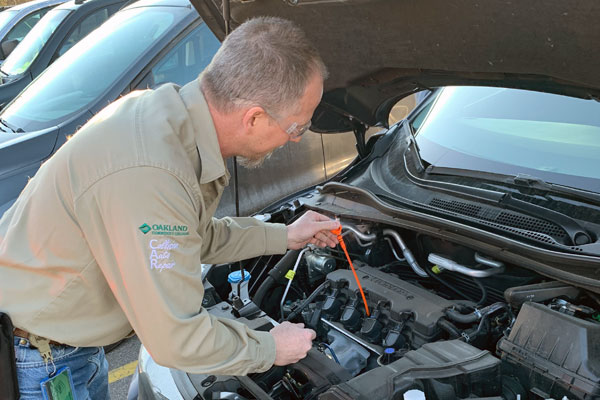Winter weather in Southeast Michigan is as unpredictable as seasonal auto repair costs. If you still haven’t prepared your car for extreme cold and snow conditions, Claude Townsend of OCC’s Automobile Servicing program says it’s not too late.

“If someone’s car was running well in warm weather, they often assume that it will be fine when the next round of winter weather hits. That false sense of security can change quickly when extreme cold and snow hit,” he said. “A little time and simple maintenance now, will go a long way to keep you on the road.”
Townsend recommends these simple preventative maintenance tips (especially if you have an older vehicle) to help avoid the dreaded call for road service this winter:
- Test Your Battery – Dead or dying batteries are one of the most frequent reasons a car won’t start in the winter. First make sure your battery connectors are tight. If there is corrosion on your battery cable connectors, clean them with a wire brush or a battery-cleaning solution. If your battery is still “sluggish” when starting your vehicle, have it tested and replaced, if needed.
- Replace Wiper Blades and Add Wiper Fluid – Having new wiper blades can give you an advantage when trying to clear the ice and snow that accumulates on your windows. And don’t forget the rear-window blade if you have an SUV. Filling the wiper fluid tank is vital to help get rid of road salt that will cakes up on your windows as you drive.
- Inspect Tire Wear and Check for Proper Inflation – Having worn tires makes it difficult to control your vehicle in snow and ice. It is a lot cheaper to replace your tires if they are worn than pay your insurance deductible when you slide on the ice or into another vehicle. New tires will help your car get out of snowy streets better, too. No matter your tires’ age, make sure they’re properly inflated. Cold weather causes air pressure in your tires to drop, causing them to become underinflated. Don’t forget to check the spare tire as well.
- Vehicle lights – Make sure all vehicle lights are functioning. If they aren’t, have them serviced. Before each trip, ensure the exterior lights are free of snow and road grime to ensure you can see, and be seen.
- Keep Gas Tank Full – Having a full tank of gas and adding fuel line treatment at every fill up will help avoid the fuel line freezing when the vehicle sits out in the cold for long periods of time.
- Check the Coolant – The proper coolant is vital to ensuring your radiator works properly to ensure you have heat and the fluid doesn’t freeze. If it is old or low, have it flushed and re-filled at a qualified service center.
- Check Engine Belts and Hoses – Cold weather reduces the life expectancy of belts and hoses. Breaks will leave you stranded. Have them checked and replaced. if needed.
- Make Sure Heating Controls are Working Properly – When you turn on your heat or defroster, make sure hot air is blowing out of vents after the vehicle warms up and that your controls aren’t loose or broken.
- Warm Up Your Vehicle – To help defrost windows and melt snow and ice, warm up your car for five minutes before you drive so the defroster has time to work. Otherwise, you can be driving with icy windows that make it hard to see.
- Charge Your EV Before You Drive – If you have an electric vehicle, make sure you have a full charge before you drive in winter weather. Cold weather can temporarily reduce an EV’s range, especially when drivers are using the vehicle’s heater to stay warm.
- Add an Emergency Kit – Even if your vehicle is ready for the winter, the unexpected can happen. Equip your vehicle with emergency supplies including jumper cables, blankets, jacket, hat, gloves, ice scraper, flares, a first-aid kit, flashlight, shovel, food, hands-warmers, and kitty litter or sand for traction if you get stuck.
While following these maintenance tips will give a vehicle a good chance of surviving winter weather on the road, Townsend said there is another tip that is vital that drivers need to heed every day.
“When driving on ice and snow there is always the chance you will slide when braking or changing lanes, especially when going too fast, even if you have all the latest anti-lock braking and anti-skid equipment on your vehicle,” Townsend said. “Don’t assume having all-wheel or four-wheel drive will stop you from sliding. It’s always better to slow down when the roads are snowy and icy to improve your chances and avoid a collision.”
He adds, “these tips will help make winter travel safer for you and passengers, and travel on snow and ice covered roads easier.”
OCC’s Automobile Servicing program offers both a certificate and an associate degree to prepare students for entry-level servicing operations in the automotive field. For more information, visit https://www.oaklandcc.edu/programs/aus/default.aspx.
About OCC
Oakland Community College offers nearly 100 degrees and certificates programs with the resource’s students need to be successful and advance our community. As a top transfer institution, OCC offers one of the state’s most affordable tuition rates and flexibility in scheduling with face-to-face and online options. The College is nationally recognized for its high-demand career training with expert faculty in their fields. More than 1 million students have enrolled in the College since it opened in 1965. Learn more at oaklandcc.edu.
###
Media Contact: Marketing & Communications | (248) 341-2020 | contactus@oaklandcc.edu